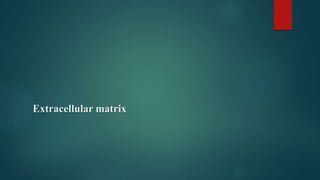
extracellular-matrix_cell_biology_cellpptx
- 2. Objectives Composition and function of extracellular matrix Biochemistry of collagen and other extracellular matrix proteins Biochemistry of specialized extracellular matrix tissues like cartilage and bone
- 3. Cells are attached to the extracellular matrix, which is a network of molecules linked to each other. Most linkages between molecules in the extracellular matrix are based on protein-protein interactions, but protein-carbohydrate adhesions also help to strengthen the molecular network. There are three adhesion mechanisms to maintain the structural integrity of tissues: cell-cell adhesions, cell- extracellular matrix adhesions, and linkages between molecules of the extracellular matrix. Here, we will deal with the third one, whereas we will learn about the other two mechanisms in the cell membrane page because these adhesions dependen on transmembrane proteins.
- 4. ECM Function Provides support and anchorage for cells. Regulates and determine cells dynamic behaviour : - polarity of cells - cell differentiation - adhesion - migration Provides mechanical support for tissues and organ architecture - growth - regenerative and healing processes - determination and maintenance of the structure Place for active exchange of different metabolites, ions, water.
- 5. Composition Structural Proteins Collagen Elastin Fibrillin Specialized Proteins Fibronectin Proteoglycans
- 6. Collagen Most abundant protein Secreted mostly by connective tissue cell and in small quantity by other cell Collagen contributes to the stability of tissues and organs. • It maintains their structural integrity It has great tensile strength The main component of fascia, cartilage, ligaments, tendons, bone and skin Plays an important role in cell differentiation, polarity, movement. Plays an important role in tissue and organ development.
- 7. Collagen synthesis 1. Synthesis of a chains of pre-procollagen on ribosomes. 2. Hydroxylation of lysine and proline in rER/Golgi by lysyl-5- hydroxylase and prolyl-4-hydroxylase. 3. Glycosylation: addition of galactose and glucose to some hydroxylysine residues (galactosyl transferase and glycosyl transferase). 4. Assembly of a-chains to form procollagen. Reaction needs the formation of disulphide bonds between registration peptides, at both ends of the prepro- collagen.
- 8. 5. Secretion of procollagen molecules by exocytosis into the extracellular space. 6. Cleavage of registration peptides is catalysed by procollagen peptidases. The resulting molecule is called tropocollagen. 7. Oxidation – deamination of the hydroxylysine, the removal of (NH2) group has a net oxidative effect and the formation of covalent cross-links. Reaction is catalyzed by lysine oxidase (or catalase). 8. Self-assembly or polymerization of tropocollagen molecules form collagen fibrils. Cross-linkage between adjacent tropocollagen molecules stabilizes the fibrils.
- 9. Clinical correlation Genetic defects Ehlers-Danlos syndrome-group of inherited conditions (eg defect in lysil hydroxylase, procollagen peptidase, or mutations in collagen type I, III and V) characterised by skin hyper-extensibility, tissue fragility, increased joint mobility> Type III very serious because of spontaneous rapture of arteries Osteogenesis imperfecta (brittle bone)- Characterised by fragile bones that break easily. Results from mutation in type I collagen Chondrodysplasia-abnormal cartilages. Mutation in type II Others Scurvy- ascorbate deficiency. Gum and skin bleeding, reduced wound healing. Unstable triple helix. Increased turnover rate.
- 10. Elastin Elastin is a major protein component of tissues that require elasticity such as arteries, lungs, bladder, skin and elastic ligaments and cartilage. It is composed of soluble tropoelastin protein containing primarily glycine and valine and modified alanine and proline residues. Tropoelastin is a 750 amino acid long protein that is highly cross-linked to form an insoluble complex. Polypeptide chains are cross-linked together to form rubberlike, elastic fibers. Each elastin molecule uncoils into a more extended conformation when the fiber is stretched and will recoil spontaneously as soon as the stretching force is relaxed Elastin It is secreted by connective tissue cells as soluble tropoelastin into EC matrix Forms cross linkages with each other-catalysed by lysil oxidase Forms an extensive network of elastin fibres and sheets Elastin fibres associate with microfibrils made up of glycoproteins including fibrillin.
- 11. Fibrillin Large glycoprotein Secreted by EC fibroblast. Found commonly in zonular fibres of the lens, periosteum, arterial wall Forms part of the insoluble microfibril which acts as a scaffold upon which elastin fibres are deposited Genetic disorder called Marfan syndrome results from mutation in fibrillin gene. Autosomal dominant. Characterised by ectopis lentis (subluxation of lenses), abnormalities of the skeleton and aortic aneurysm (dilatation) Marfan Syndrome.
- 12. Fibronectin High-molecular weight (~440kDa) glycoprotein Attached to cell membrane by membrane-spanning receptor – integrin. Crosslinks and stabilizes other components of ECM Enhances cell addhesion to extracellular matrix components (collagen, fibrin and heparansulfate proteoglycans). Related to blood clotting - soluble FN crosslinks platelets together using membrane bound heparin Functions. related to cell adhesion, differentiation, growth, migration; • anchoring basal laminae to other ECM; • plasma fibronectin forms a blood cloth, along with fibrin; • related to cell movement - groups of embryonic cells follow a FN pathway -FN guides macrophages into wound areas.
- 13. Glycoproteins Glycoproteins greatly contribute to make the extracellular matrix a cohesive network of molecules, although they also perform other functions. Glycoproteins are intermediaries that link structural molecules between each other, and also link structural molecules and cells. In each glycoprotein molecule, there are several domains binding different molecules that altogether forms cross-linked molecular networks. Fibronectins, laminins and tenascins are major glycoproteins of the extracelular matrix of animals.